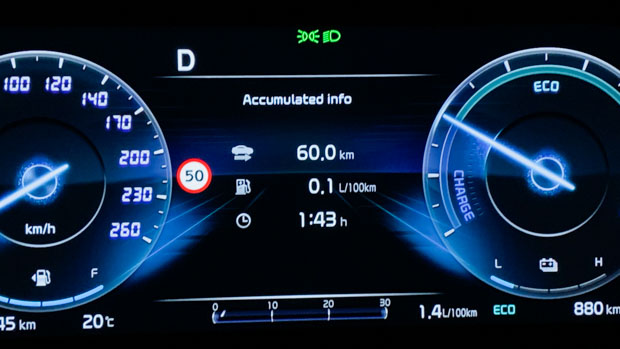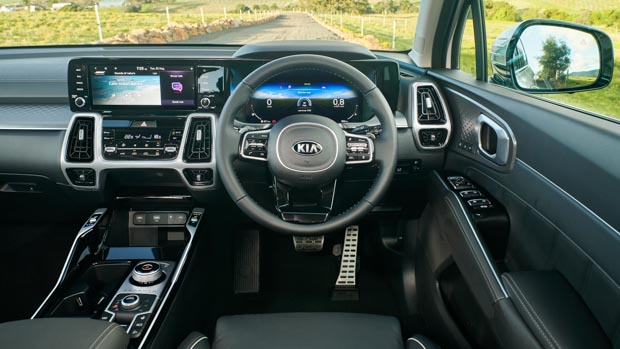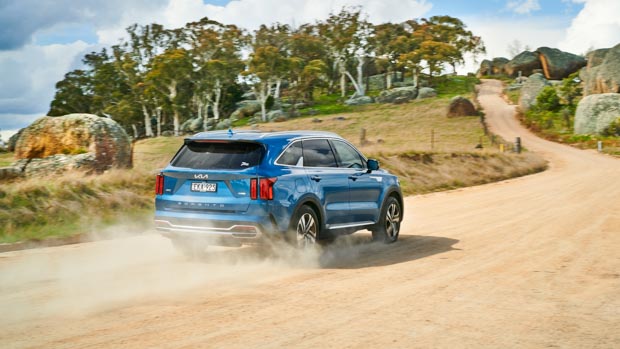-
Car Reviews
- All reviews
- Midsize SUVs
- Small cars
- Utes
- Small SUVs
- Large SUVs
- Large cars
- Sports SUVs
- Sports cars
- Vans
Latest reviews
- Car News
-
Car Comparisons
Latest comparisons
- Chasing Deals
The Kia Sorento GT-Line plug-in hybrid may be expensive, but the closer you look, the more sense this seven-seater makes

Having been educated on a diet of Toyota hybrids for the last 10 years, Korean carmaker Kia believes the time is now right to introduce Australian families to plug-based motoring.
Enter the Kia Sorento plug-in hybrid. There is a more modest self-charging, Toyota-style Sorento hybrid coming next year, but for now, the big news is the PHEV.
Much like a fully-electric car, a plug-in hybrid is recharged from a wall outlet. Unlike a Toyota-style hybrid, PHEVs have a substantial battery offering the ability to force the car into driving only on electric power, at virtually all speeds.

Or, you can tell the system that you want the battery, electric motors and the – in this case – underlying 1.6-litre turbo petrol four-cylinder engine to work together to produce 195kW of power and 350Nm of torque, making the Sorento plug-in hybrid feel spritely.
The basic use case is this, however: run your urban commute or the school run on electric power alone, emitting no tailpipe emissions, and then rely on the petrol engine for longer runs, like family road trips. It’s almost like having two cars in one.
As with everything in life, though, there are compromises.
The first is cost: at $81,990 driveaway, the GT-Line plug-in hybrid is $14,700 dearer than the GT-Line diesel. You’d need to seriously commit to recharging the Sorento and tapping into its 60km real-world electric-only range to make up the difference across half a decade or so.

To be fair, the Kia is a few bucks cheaper than the rival Toyota Kluger hybrid, which doesn’t have any electric-only range as it is a more basic series-parallel hybrid.
Plus, Kia says it is looking at introducing less posh plug-in hybrid variants from next year. For now, though, semiconductor shortages across the carmaking industry forced the brand to bring just one trim, and it settled on the popular and top-shelf GT-Line.
The second compromise is weight. Introducing a 14kWh battery to the Sorento platform and an electric motor adds 148kg over the already bulky diesel, bringing tare weight for the PHEV to 2,056kg.
Does this really matter? And how does the Sorento plug-in hybrid stack up in the real world?
Kia’s decision to equip the Sorento with a plug-in hybrid system makes it totally different to drive than, say, a Kluger hybrid.
Australia is now quite used to what are known as series-parallel hybrids – sometimes referred to as “self-charging” hybrids. They’re self-charging because they have tiny batteries that are capable of being recharged under braking. Essentially, these hybrids reduce fuel consumption by 30 percent or so.
That’s meaningful, but it isn’t nearly as sophisticated as a plug-in hybrid system, which provides the car with actual electric-only range – as in, you can drive a PHEV on electricity for a good distance before the underlying combustion engine has to kick in.
In the case of the new Sorento plug-in hybrid, the electric range is rated at 56km (WLTP) but our testing in mixed driving conditions around Sydney revealed the true range to be 60km on volts alone.

That’s really quite decent. Other PHEVs seen on Australian roads, including a number of Volvo models, have generally struggled to crack 50km before turning over the engine.
Our view of PHEVs is that it is best to charge them, use up their electric power in urban driving, and then allow the petrol engine to start if you need to drive further afield.
Unplug the Sorento from its max-3.3kW AC charging session – you’ll get more like 2kW if you don’t have an installed wall box – and you can drive off on electric juice, with the transmission-mounted motor producing a modest 67kW of power along with a muscular 304Nm of torque.
If you indulge in traffic-light drag races then the petrol engine will force itself to intervene to provide maximum acceleration, sensing that you seriously need to shift the vehicle in an emergency setting.

Avoid full-throttle starts in electric mode, though, and the Sorento whirs away silently from rest and accelerates quite confidently, if not that quickly, up to the highway speed limit.
The feel of the regenerative braking under foot is a bit artificial but not the worst we’ve tested, and the Sorento recoups a fair amount of energy on long downhill stretches.
As you’re watching the battery percentage tick downward something odd happens. At 15 percent charge remaining the engine is forced on by the management system.
In effect, this means you only get 12kWh of energy to use on electric power alone, not the full 14kWh. The reason for this is so that the Kia always has some electric torque to deploy to assist the petrol engine – the high-voltage battery isn’t allowed to run flat like it is in some PHEVs, where it becomes a dead weight.


So the 1.6-litre petrol kicks on, providing its own 132kW of power and 265Nm of torque, though this is academic. There is always some assistance from electricity, bolstering those numbers toward their 195kW/350Nm combined peaks, driven through all four wheels. The Sorento plug-in hybrid is AWD.
Throw efficiency to the wind, select Sport mode from the Sorento’s bevy of drive settings and it can fly off the line … when it works out your intention. There is too much lag in the system when you’re requiring electricity and petrol to combine.
In some cases we found the Sorento waited over 2 seconds at full throttle before proceeding as the computers worked out the right mix of energy for the demand.
But eventually it all comes together and you find Kia has struck a pretty good mix here. The Sorento plug-in hybrid feels quite normal to drive and, in electric mode, it’s really serene for urban duties.

And then a few corners hit and suddenly the 148kg of additional weight becomes evident. There’s still decent grip here from the Continental rubber, but the suspension starts to heave under the extra load. There is a surprising deficiency of poise compared to the relatively controlled V6 petrol and diesel models.
Significant mid-corner bumps trigger more rear-end body motion because that’s where you’ll find almost all of the extra weight, the battery being nestled above the rear suspension and (commendably) full-size spare tyre. If there has been a revision to the damping to account for this impediment … it is not evident.
What is evident is that the alloy wheels have been downsized from 20-inch on the GT-Line V6 and diesel variants to the same, dowdier-looking 19-inch wheels normally found on the combustion Sport Plus grades.
They may not look as good as the blinged-out chrome kicks of the regular GT-Line, but boy – do they insulate the urban ride. In fact, the smaller wheels make the plug-in hybrid the best-riding top-spec Sorento around the ‘burbs.

The body control only starts to fall apart when you’re punting the Sorento plug-in hybrid down a country road. In urban spaces, the ride is good and the body control doesn’t become problematic.
Brake feel is often weird in hybrids and so it goes with the Sorento – you just have to learn to adapt to the wooden feeling of the pedal as the car’s management system decides whether to tap into regenerative braking or utilise the physical brakes instead.
Refinement, though, is excellent – particularly in electric-only mode where the only powertrain disturbance is a slight whir from the motors. Even when the petrol engine is engaged it rarely thrashes; unlike a Toyota hybrid this combustion unit is turbocharged, meaning it does not require high revs to make high torque.
The Sorento continues to demonstrate good safety system tuning, with accurate lane keeping and holding assistance and well-sorted adaptive cruise control. Like other GT-Line Sorentos, the plug-in hybrid also scores Kia’s excellent blind spot camera system, which is superior to traditional blind-spot sensors in our testing.
Aside from a few bespoke switches that force the Sorento PHEV into electric-only or blended hybrid mode – and some unique instrument cluster graphics – you would barely know this was not a regular Sorento GT-Line.
And that is the whole point: unlike the oddball Kia Niro, the Sorento hybrid isn’t intended to be a virtue-signaller. Like the combustion versions of this large SUV, the Sorento is handsome, conventional, even a little tough outside – and it’s fairly well-appointed inside as well.
Being a GT-Line means picking up the full kit and kaboodle inside – and you’d hope so at just under $82,000 driveaway.
The mix starts with soft nappa leather upholstery throughout. The seats sport a charming watch-strap pattern; the front pews score cooling while rows one and two are heated. There is memory for the driver’s seat while the front row chairs both have electric adjustment.

Ten-inch and twelve-inch respectively, the centre touchscreen and driver’s digital display are generously-sized, bright and crisp in resolution, giving the cabin an up-to-the-minute feel.
Yet the Sorento’s interior is not intimidating or tech-dominated, as Kia have reserved plenty of real buttons and knobs for things that matter: temperature, fan speed, volume, drive modes. And even the infotainment software is easy to master quickly.
Navigation, Bluetooth and AM/FM/digital radio are built in, playing through a Bose stereo, but like many other Kia and Hyundai products, there is no wireless CarPlay or Android Auto here. Instead, you’ll need a USB cable, though phones can be charged wirelessly.
If only the cabin wasn’t so dark; a combination of oppressive black leather and artificial metal accents that certainly don’t look or feel real keeps the Sorento plug-in hybrid from feeling special enough for a price on the wrong side of eighty grand.

In other markets, including South Korea, a far more fetching caramel/navy two-tone interior can be optioned, immediately giving the interior the kind of lift it deserves at this ambitious price point.
Kia would do well to bring a light colour option to Australia for the Sorento GT-Line.
No complaints about seat comfort, though; the pews are certainly firmer than most Kia products but that’s fine – they are ergonomic and supportive, European-style, and their active ventilation keeps them cool despite Australian summer weather slowly creeping back.
Passengers seated in the second row will find it spacious and airy, with large windows equipped with sun blinds. Legroom and headroom is excellent, even with the middle row adjusted forward to provide ample room for those in the way-back. There are air vents and more USB ports back here, plus a flip-down centre armrest if you’re four-up.

Moving to the third row reveals a bigger space than you might expect. While Kia’s Carnival van is a better solution for big families, you can’t have the Carnival as a plug-in hybrid and it doesn’t quite have the Sorento’s cool-factor.
Cupholders, vents and USB ports continue in the final row but the curtain airbags here only cover the glass, rather than the vehicle body as they do elsewhere in the vehicle.
Impressively, the big hybrid battery barely robs any boot space from this PHEV. That’s rare for a plug-in hybrid and speaks to Kia’s packaging excellence. Storage under the boot floor is sacrificed, but a full-size spare is slung beneath the vehicle.

In five-seat mode boot space for the Sorento PHEV is 604 litres, down slightly from 616L in the V6 petrol and diesel. With all seven seats in place boot space is 175L, down from 187L.
Towing capacity does take a hit, though. The V6 and diesel versions of the Sorento can tow 2,000kg with 200kg towball download, whereas the plug-in hybrid is limited to towing 1,350kg with 100kg download.
If you really engage with the Sorento PHEV, charging it up whenever you can, you will extract very low running costs from this large SUV.
That is because at current prices, running the Sorento on electricity is much cheaper than running it for the same distance on either petrol or diesel.
In our testing, the Sorento used 20kWh/100km of electricity (providing 60km from 12kWh of energy). At a cost of $0.25/kWh, common in NSW, this means travelling 100km on electricity costs $5 in the Sorento.
Meanwhile, if you achieve 7.5L/100km in the Sorento diesel, which is a normal result for town driving, you’d expect to pay about $11 in fuel at $1.45/litre of diesel. In the V6 petrol you’d expect to use more like 12L/100km, with the same 100km costing you closer to $16.

If you do 10,000km each year on urban roads – say, your commute – you’d spend $500 on electricity compared to about $1,100 on diesel. If you generate your own power at home with solar you could even run the Sorento on electricity for next to nothing.
But even if you have household solar it will still take the best part of a decade to make up the $14,700 difference when compared to the Sorento GT-Line diesel.
That means this car is less about saving you money and more about making an impact on your personal CO2 footprint. In the absence of tax penalties for the V6 petrol and diesel, this choice will matter more to some buyers than others.
Once the battery is depleted – remembering the Kia forces its own charge to not go lower than about 15 percent – we recorded between 6.6L/100km and 7.5L/100km when relying upon the 1.6-litre turbo petrol. That’s diesel-like as the engine shuts off and relies on the electric motors whenever it can, for example, when moving off from rest.

There is an important differentiator contained within the Sorento’s seven-year warranty.
The vehicle itself is covered for unlimited kilometres within that seven-year period, but the high voltage battery and hybrid system is only covered for seven years/150,000km.
Capped price servicing will be offered for the Sorento plug-in hybrid but the final costs have not yet been locked in. We do have some indicative figures, though, which we will update if there is a change.
Scheduled maintenance is required every 12 months/10,000km – that distance interval is on the short side. Over 5 years/50,000km the cost adds up to $3080 while the full 7 years/70,000km accumulates to $4903.
If any car can make plug-in hybrid motoring appealing to family buyers, it should be the Kia Sorento GT-Line.
Attractively styled, plushly-appointed and spacious, with no intrusion to the boot from the substantial hybrid battery, the Sorento-with-a-plug makes life easy.
It also makes everyday running quite cheap if you lean into the plug-in hybrid lifestyle, charging the vehicle up every night or two so that your urban commute or school run is done on electric juice alone.
If you have household solar, you’re laughing, with the 60km of electric running the Sorento PHEV offers effectively coming for free.

Then, the underlying petrol engine offers easy flexibility for road trips – quite convenient as Australia’s long-distance EV charging infrastructure remains patchy.
At $81,990 driveaway there is no doubting that this is an expensive Kia, but the price is lineball with the less sophisticated Toyota Kluger Grande Hybrid.
For the family increasingly conscious of their carbon footprint, that makes the plug-in Sorento more than worth a look.
Key specs (as tested)
About Chasing cars
Chasing Cars reviews are 100% independent.
Because we are powered by Budget Direct Insurance, we don’t receive advertising or sales revenue from car manufacturers.
We’re truly independent – giving you Australia’s best car reviews.
The estimate provided does not take into account your personal circumstances but is intended to give a general indication of the cost of insurance, in order to obtain a complete quote, please visit www.budgetdirect.com.au. Estimate includes 15%^ online discount.
^Conditions Apply
Budget Direct Insurance arranged by Auto & General Services Pty Ltd ACN 003 617 909(AGS) AFSL 241 411, for and on behalf of the insurer, Auto & General Insurance Company Limited(ABN 42 111 586 353, AFSL 285 571).Because we don’t know your financial needs, we can’t advise you if this insurance will suit you. You should consider your needs and the Product Disclosure Statement before making a decision to buy insurance. Terms and conditions apply.
Indicative quote based on assumptions including postcode , 40 year old male with no offences, licence suspensions or claims in the last 5 years, a NCD Rating 1 and no younger drivers listed. White car, driven up to 10,000kms a year, unfinanced, with no modifications, factory options and/or non-standard accessories, private use only and garaged at night.
^Online Discounts Terms & Conditions
1. Discounts apply to the premium paid for a new Budget Direct Gold Comprehensive Car Insurance, Third Party Property Only or Third Party Property, Fire & Theft Insurance policy initiated online on or after 29 March 2017. Discounts do not apply to optional Roadside Assistance.
2. Discounts do not apply to any renewal offer of insurance.
3. Discounts only apply to the insurance portion of the premium. Discounts are applied before government charges, taxes, levies and fees, including instalment processing fees (as applicable). The full extent of discounts may therefore be impacted.
4. We reserve the right to change the offer without notice.